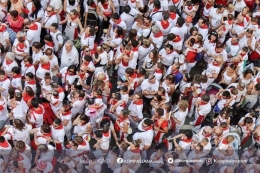Chitosan and Trametes versicolor were used as the material for processing liquid waste product from the jeans washing industry. This study as they were more economis and no negative damage in environmental life. This Reseach is to find out of chitosan and Trametes versicolor effect as the coagulant in decreasing the colour and the COD content of the liquid waste product from the jeans washing industry using the coagulant method and flocculation. The dosage of chitosan and Trametes versicolor were 400, 600, 800, and 1000 mg/L of the loquid waste product whereas the combination of chitosan and Trametes versicolor were 4:1, 3:2, 2:3, and 1:4.
The data resulted from the analisys were shown as a graphics. The research result show that the optimum dosage of chitosan as coagulant was 800 mg/L which was abe to decrease the colour intensity. For blue colour, the intensity decreased from 1.2 to 0,1%; the yellow colour intensity decrease from 0,9 to 0,0% and the COD 91,23%.
The optium dosage of the tremetes versicolor of 600 mg/L was able to decrease the blue intensity from 1.2. to 0,11%; the yellow colour intensity decrease from 0,9 to 0,0% and the COD 91,23%. By using the combination of chitosan and trametes versocolor it was shown that the best result was usingthe 3:2 ratio which was able to decrease the blue colour intensity from 0,9 to 0,1% and the yellow intensity from 0,9 to 0,0% and the COD was 86,68 %.
References
- Fessenden R.J., Joan S.F., 1982, Organic Chemistry,2nded, Willard grant press, Massachusetts.
- Departemen perindustrian, 2007, Pengelolaan Limbah Industry Pangan,Direktorat Jenderal Industri Kecil Menengah, Jakarta.
- Brown, D.T., 1999, The Rs -- A Framework For Responsible Waste Management,http;//www.brocku.ca/epi/cief/fours.htm.
- Sirait, I.R., Pemanfaatan Kitosan Dari Kulit Udang(Peneus Monodon) Dan Cangkang Blangkas(Tachypleus Gigas), Untuk Menurunkan Kadr Ni, Cr, Limbah Cair Industri Pelapisan Logam, Tesis, Program Studi Lingkungan Pascasarjana, USU.
- Rama, D.P., and Rama K.N.G., 1990. Analyst,115, 1469-1471.
- Juliana A. Ramsay dan Chris goodde, 2007, Biodegradatio Of Wheat Straw By Trametes versicolor.
- Gao, Y., Lee, K-H., Oshima, M., and motomizu, s., 2000. Anal.sci., 16, 12, 1303-1308.
- Filho. J.A.R., Bach, E.E., Barrack, E.R., And Querioz, A.A.A 2001, Mat. Rea.,4, 2, 53-57.
- Rismauli, s., 2001, Penggunaan Kitosan Untuk Menurunkan Kekeruhan, Nilai Permaganganat, dan Padatan Total pada Air Tanah Gambut, Jurusan Kimia FMIPA-USU.
- Muzzarelli, R.A.A., 1997, Chitin, Pengamon Press, Ltd. Oxford, England.











